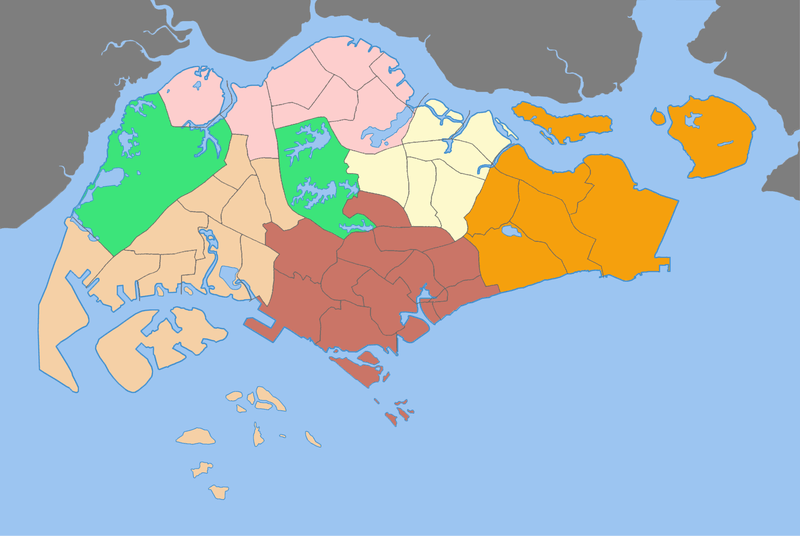Regions of Singapore
The Regions of Singapore are urban planning subdivisions demarcated by the Urban Redevelopment Authority of Singapore to aid in its planning efforts. Over time, other governmental organisations have also adopted the five regions in their administrative work, as for example the Department of Statistics in the census of 2000. The regions are further subdivided into 55 planning areas, which include two water-catchment areas. The largest region in terms of area is the West Region with 201.3 km2 (77.7 sq mi), while the Central Region is the most populous with an estimated population of 922,980 inhabitants in the area in 2019.[3]
| Regions of Singapore | |
|---|---|
 | |
| Category | Unitary state |
| Location | |
| Created by | Urban Redevelopment Authority |
| Created | September 1991 (proposed)[1] 22 January 1999 (gazetted)[2] |
| Number | 5 (as of 2019) |
| Populations | 573,950 (North Region) – 922,980 (Central Region)[3] |
| Areas | 93.1 km2 (35.9 sq mi) (East Region) – 201.3 km2 (77.7 sq mi) (West Region)[3] |
| Government | CDC districts National Government |
| Subdivisions | Planning Areas |
While used by some governmental organizations, these regions are not administrative subdivisions. For administrative purposes, Singapore is divided into five districts and further divided into divisions governed by councils and headed by mayors. These subdivisions are incompatible with the regional subdivisions. The regions are fixed over time while the districts fluctuate with electoral redistricting.
List of regions
| Region[3] | Regional Centre | Largest PA by area | Largest PA by population | Area (km²) | Estimated
Population[4] |
Population density (/km²) | Planning Areas |
|---|---|---|---|---|---|---|---|
| Central Region | Central Area (de facto) | Queenstown | Bukit Merah | 132.7 | 922,980 | 6,955 | 22 |
| East Region | Tampines | Changi | Bedok | 93.1 | 686,050 | 7,369 | 6 |
| North Region | Woodlands | Central Water Catchment | Woodlands | 134.5 | 573,950 | 4,267 | 8 |
| North-East Region | Seletar | North-Eastern Islands | Sengkang | 103.9 | 921,940 | 8,873 | 9 |
| West Region | Jurong East | Western Water Catchment | Jurong West | 201.3 | 921,340 | 4,577 | 12 |
| Total | 665.5 | 3,902,692 | 5,864.3 | 55 |
See also
- Planning Areas of Singapore
- Subdivisions of Singapore
References
- "HistorySG - 1991 Concept Plan is unveiled". National Library Board.
- "Singapore Infopedia - Development guide plan". National Library Board.
- 2019 City Population - statistics, maps and charts | SINGAPORE: Regions Retrieved April 5, 2020.
- Populations do not include approximately 1.6 million non-permanent residents of Singapore